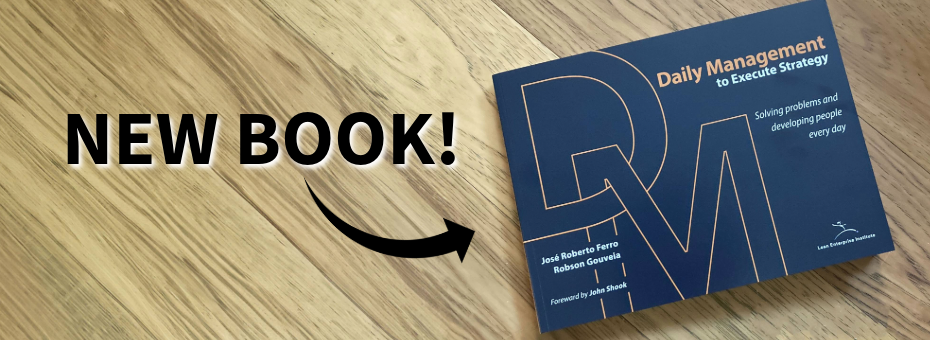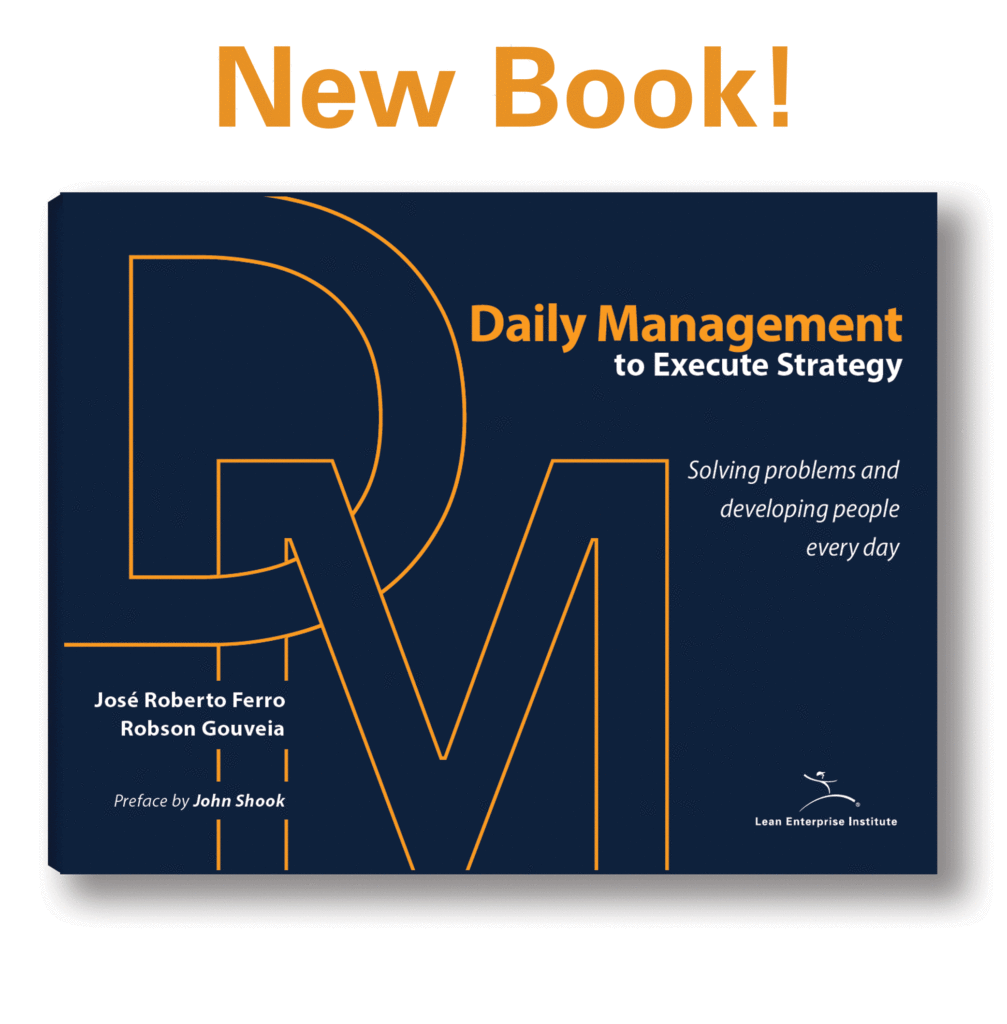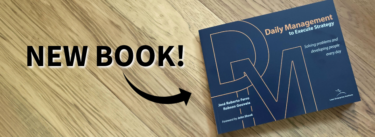INTERVIEW – As their book on daily management is released in the US in English, we talk to the authors about the thinking behind the book and the lessons learned since its launch in Brazil three years ago.
Interviewer: José Roberto Ferro and Robson Gouveia
Interviewee: Alexandre Possendoro
Lean Institute Brasil: What motivated each of you to write and publish Daily Management to Execute the Strategy?
José Roberto Ferro – After founding Lean Institute Brasil (LIB) and working for many years with various organizations across different aspects of management, I realized that one of the most common difficulties companies faced with their strategy was the inability to deploy it and allow it to reach operational levels. Strategy was often based on intentions, desires, and wishes, sometimes accompanied by an overwhelming number of metrics and a very disjointed and disorganized process. That led me to ask myself how I could help companies improve the deployment, execution, and monitoring of their strategy in daily operations.
Robson Gouveia – I had practical implementation experience, having lived through Daily Management (DM) within Alcoa, a giant in the aluminum sector, in the early 2000s. I noticed that, with DM in place, we had greater success in executing the strategy and involving people at all levels. When I joined LIB, I realized that this practice was not common in other companies.
That’s when Professor Ferro and I saw an opportunity to disseminate this knowledge to our extensive community. Knowing how big of a challenge strategy execution is in organizations (based on my experience at Alcoa and Prof. Ferro’s observations on the field), before we even started to think about a book, we published an article on Planet Lean about DM and strategy.
JRF – To our surprise, the article was a great success. For over two years, it was the most-read piece on Planet Lean. We thought that DM was a marginal topic in the lean discourse and were surprised to see so much interest from the global lean community. We decided we had to build on the success of the article to help more and more companies apply a process that can bring excellent results but is often ignored.
RG – Before starting work on the book, of course, we conducted extensive research to understand what already existed out there around the topic of DM. And we didn’t find anything particularly useful or practical. At that point, we knew that we could make an important contribution.
JFR – We then decided to write this book in a very practical way, in the spirit of LIB and other Lean Global Network affiliates around the world, with the aim of communicating these concepts in a simple way so that companies could use them. That’s why this book is not “academic”; rather, it uses various examples and tries to translate the Daily Management concepts in a way that makes them easy to apply for companies.
LIB: What are the main contributions the book has made to organizations?
JRF: We managed to bring together different tools and approaches related to lean transformations, organizing them into three major blocks of Daily Management. First, we made it clear that good DM requires commitment. Why are we doing it? What are the challenges, objectives, and goals? Who participates, and when? How is this meeting organized?
The second block is what we call control variables, which are what companies monitor on a daily basis to know if what was planned is being delivered as expected. If something is wrong or unattainable, how can we ensure that people notice and act promptly to prevent deviations from becoming bigger problems?
The third block within DM is problem solving for issues that couldn’t be solved immediately or on the same day. It helps companies to organize themselves and prioritize actions appropriately.
In our mind, these are the three elements that characterize Daily Management. Even though they are often disconnected from one another within companies, we believe that with DM organizations can start seeing them as parts of an integrated process.
With this in mind, I think that a major contribution was helping companies identify which variables are truly relevant. Too often, organizations have meaningless variables and metrics, and that is often because they don’t take the time to ask people what is most relevant to their daily work.
Another significant contribution was deepening problem-solving, a topic all companies talk about but that is generally completely detached from daily practice. More often than not, it’s either scattered around the company in “islands of improvement” or relegated to a specific quality or improvement department. In our book, we explain why bringing problem solving into daily operations is so crucial.
We also warn readers against trying to implement Daily Management in an environment that lacks psychological safety and the right leadership style. Without these two elements, DM will simply die out. How can we expect people to raise problems when they don’t feel safe?
RG: When people are connected with the company’s purpose and understand how they can contribute to it, the dynamics change completely. People have much more willingness and eagerness to contribute. Leaders need to understand that a 15- to 30-minute meeting every day is the best “school” they can offer their employees. That’s where they are learning. Psychological safety will allow for the creation of a learning environment focused on solving the real problems of the area. It’s what makes sense to the employees.
It goes beyond that. Because Daily Management can and needs to be increasingly sophisticated. In the book, we present the ideas of Operational DM and Managerial DM. Operational DM involves following up with front-line staff so they can meet and discuss and address problems. When they can’t resolve an issue at the operational level, there can be an “escalation” prompting a chain of help, where the managerial level (which is looking at the whole) can provide assistance. Daily Management connects operations and management, creating a well-defined chain of help with well-defined support mechanisms. It’s what we call a management system, which lies at the heart of the Lean Transformation Framework (LTF).
JRF: Right in the first chapter of the book, we also highlight the essential role of DM in the quick resolution – or, at least, identification – of problems. While addressing them is often complex, requiring the involvement of multiple areas and cross-functional management, there is great value even just in quickly exposing problems. Flagging up abnormal situations every day means alerting the system and preventing a problem from becoming too big or being addressed too late.
RB: I think that another contribution of the book is combating the “hero culture” that suggests that the person who solves problems should always be a specific manager or expert. What we want, instead, is to empower, equip, and create a management system where everyone can solve problems at all levels. Another important point that companies are increasingly concerned about is giving prominence to people in a collective and collaborative way. In companies practicing DM, people feel collectively responsible because they understand their role in executing the strategy and because they have the autonomy to solve problems every day.
LIB: Is this book more suitable for companies that have already started a DM process and need to improve it? Or can and should it also be used by companies that are entirely new to it?
JRF: More mature companies will have a set of tools and techniques in place, probably some degree of visual management and some kind of mechanism for meeting – whether they call it a huddle, a stand-up meeting, or else. But what’s often missing is the connection with the strategy (the translation of the purpose of a specific area into deliverables and concrete actions), control variables, and problem solving in a suitable environment. This means that mature companies can greatly benefit from adopting the approach to DM we write about, even though it may seem like they have it all figured out.
As for companies that are just starting out, the book offers an excellent opportunity to begin correctly – connecting with the strategy and purpose, developing front-line people, and improving the processes that truly add value to the customers. Starting DM in the right way is key to initiating a lean transformation.
LIB: What obstacles do you typically observe to the dissemination, understanding, and practical implementation of the teachings of this book?
JRF: In recent years, we have carried out projects in various types of companies and businesses of different sizes, sectors, and countries. Many of these implementations of DM have been very successful, but we have also encountered some difficulties.
For example, regarding the first Block (Commitment), we have observed that companies often lack a well-formulated strategy and struggle to define their True North. This makes it very difficult to identify the purpose of each specific area. Thus, we have been trying to help organizations build their strategic planning from the bottom up, even though the creation and operationalization of the Daily Management might take a little bit longer.
RG: Another difficulty we have noticed in companies is the creation and sustainment of the routines necessary for Daily Management. It sounds simple enough, but sometimes it’s difficult to stick to meeting schedules, gather the teams that need to participate, and promote real contributions from each team. Creating such discipline is often a major challenge, but only when people embrace the ritual and cadence of solving problems every day and every level will the organization become truly agile (and the number of meetings and emails will drop accordingly, by the way).
The second and third blocks also create challenges for organizations. For example, it can be quite hard for them to define and work with indicators. When it comes to structuring the control variables of DM, an overwhelming number of indicators typically appear, and the most important ones are sometimes not even there. Companies also struggle to structure their problem-solving system by making sense of the many methods and techniques they have in use. This generally results in a confused and disjointed problem-solving system that remains largely “invisible” to people, which is what we strive to avoid with DM.
JRF: I agree. Structuring the problem-solving process is always a major challenge, and a lot of it has to do with the social dimension of Lean Thinking. Managers often think that their role is to give orders and assign tasks but ultimately solve problems by themselves, when in reality, they need to understand that they should help front-line people to do that. They are the ones working at the gemba, where deviations occur, after all. In a lean organization, the role of management is to create the conditions for people to succeed. This goes hand in hand with promoting standardization, which traditional organizations often think they don’t need because the leader is capable of “solving it all”.
LIB: What do you hope this book will achieve?
RG: There are a number of successful projects, but we realize that building a DM is not as intuitive as we would like it to be. My hope is that people could read the book and, by the following week, be able to implement the three blocks and have a DM system up and running. It’s not like that. We have to build the blocks step by step. This takes time and requires maturity.
Order your copy of Daily Management to Execute Strategy today! Orders of 10 or more copies receive a discount.








